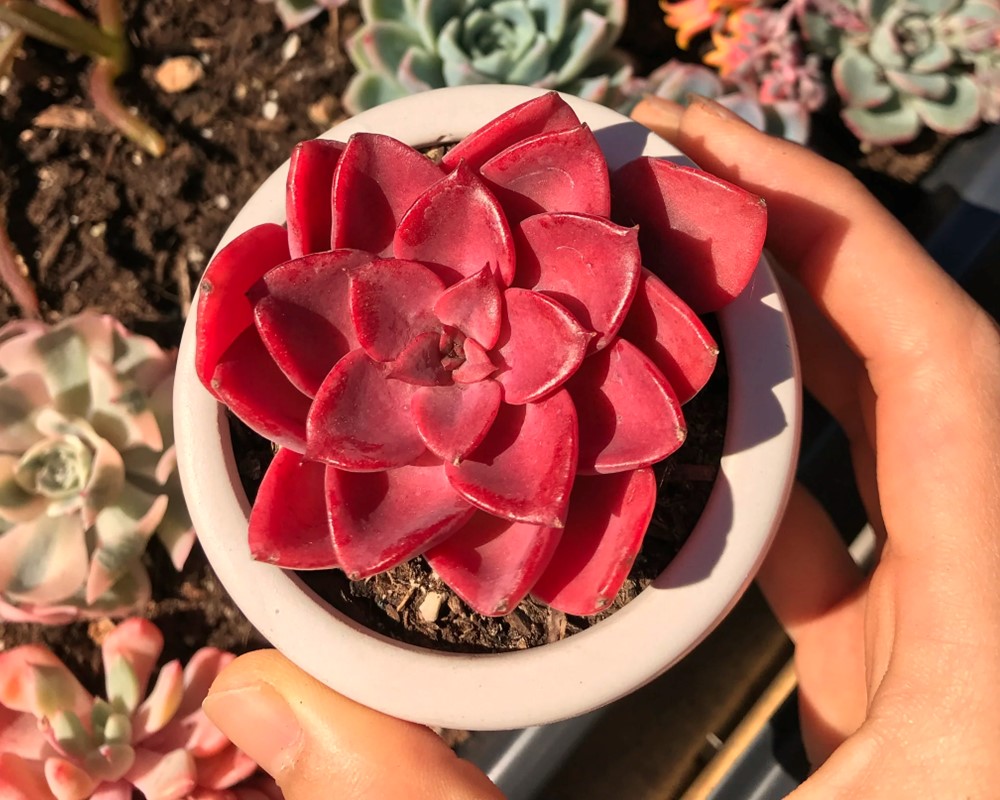Some factors are involved in turning red succulents including sunlight, temperature, water stress, and genetic characteristics. In this post, I will discuss these factors and even more. I will give you a list of red succulents and teach you how to make them turn red. Keep reading.
What Does it Mean When Succulents Turn Red?
Some people become concerned when spot the red leaves of their lovely succulent. They often ask me about its reason. Don’t worry, it’s usually a good thing (at least not a bad thing)! Reddish hues in succulents often indicate they’re thriving although it can be also a sign of special conditions. in the following, I will discuss it in detail, and finally can you detect the exact reason for turning red your succulents.
Why Do Succulents Turn Red?
Here are the common reasons for red succulents.
Increased Sunlight
- Sun Stress: This is the most common cause. Succulents produce anthocyanin, a pigment that gives them a reddish tint, to protect themselves from intense sunlight.
- Balancing Act: While some sun stress is good, too much can harm your succulent. Monitor the color change and adjust its location if necessary. read my other post ” Best Small Low-light Succulents for Indoors“.
Temperature Changes
- Seasonal Shifts: As temperatures drop or rise, succulents may react by changing color. This is a natural response to adapt to the environment. Read my other post “Caring for the succulents in winter“.
Water Stress
- Not Overwatering: Believe it or not, under-watering can also cause reddening. Succulents store water in their leaves; when dehydrated, they may change color to conserve water.
- Finding the Balance: Ensure you’re allowing the soil to dry completely between waterings to avoid root rot.
Natural Variation
- Genetic Makeup: Some succulent varieties are naturally prone to red or purplish hues. (read my other post “Why is my Purple Plant turning green?”.
Nutrition and Red Succulents Color
Some people ask me are nutrition has an impact on succulent colors. No, based on my experience nutrition (fertilizer) typically doesn’t have a direct impact on succulents turning red. Although too many nutrients can lead to excessive growth and prevent the plant from producing anthocyanins, the pigments create rich reds and purples.
In addition, Nutrient deficiency while not the primary factor causing the red coloration, a plant that isn’t receiving adequate nutrients will be overall less healthy. A less healthy plant might be more susceptible to stress, which can trigger the production of anthocyanin (the pigment causing the red color). So, try to feed your plant with adequate liquid fertilizer.
However, it’s important to note that:
- Nutrient deficiencies usually manifest in other symptoms first, such as yellowing leaves, stunted growth, or weak stems.
- The red colouration is more often linked to environmental factors like sunlight, temperature, and water stress.
How to determine the exact cause?

Consider these factors to find the exact cause of turning red of your succulents:
- Recent changes: Have you moved your succulent, changed its watering routine, or experienced significant temperature fluctuations?
- Appearance: Is the reddening uniform or concentrated in specific areas?
- Succulent type: Some species are more likely to develop red tints than others.
Protocol to Encourage Reddish Tints in Succulents
Some people like to make their lovely succulents turn red, it’s nice. In the following, I provided a guideline, by following it, you can encourage reddish tins in your succulent while keeping it healthy.
Disclaimer: While this protocol can encourage red coloration, it’s essential to monitor your succulent closely to prevent stress or damage.
Understanding the Process
Succulents produce anthocyanin, a pigment that gives them reddish hues, as a response to stress. This stress can be induced by increased sunlight, temperature changes, or slight water deprivation.
Guideline
- Increase Sunlight Exposure:
Gradually expose your succulent to more direct sunlight. Start with a few hours of morning sun and gradually increase the duration. Monitor for signs of sunburn, such as brown spots. If this happens, reduce the sunlight exposure.
- Temperature Variation:
If possible, expose your succulent to cooler night temperatures (but above freezing). This can enhance color intensity. Avoid extreme temperature fluctuations.
- Controlled Water Stress:
Allow the soil to dry completely between waterings. This can encourage color development. However, avoid excessive dryness, as this can harm the plant.
Patience:
Color changes can take several weeks. Be patient and observe your succulent’s response.
- Tips you should consider to make your succulent turn red
- Succulent Variety: Some succulents are naturally more prone to reddening than others.
- Soil Drainage: Ensure your succulent is planted in well-draining soil to prevent root rot.
- Fertilization: While not directly impacting color, providing a balanced succulent fertilizer can promote overall plant health.
- The goal is to stress the plant slightly, not harm it. Monitor your succulent closely and adjust the protocol as needed.
Can All Succulents Turn Red (Red Succulents)?
No, not all succulents turn red. While many succulents can develop reddish hues under certain conditions, not all of them will. Some factors influencing this include:
- Species: Some succulents are genetically predisposed to produce more anthocyanin, the pigment responsible for red coloration.
- Growing conditions: Increased sunlight, temperature fluctuations, and slight water stress can encourage red coloration, but these factors might not affect all succulents equally.
List of Succulents Known for Their Potential Red Coloration
Below you can see a list of succulents that can turn red. Please notice that even if a succulent is capable of turning red, it might not always do so. The specific conditions and the plant’s characteristics play a significant role.
- Echeverias
- Sedums
- Crassulas
- Sempervivums
Conclusion
I told you that some succulents like Sempervivums, Crassulas, Sedums, and Echeverias can turn red in specific conditions including sunlight, temperature, water stress, and genetic characteristics. I also gave you a protocol to encourage red succulents to turn to reddish tints.
Do you have a red succulent? Can you determine why it turns red? Sunlight? Water stress? Do you want to make your green succulents turn red? Do you think the above guideline can work well? Please share with my readers and me your experiences and ideas below this page. you can also ask me your questions. I will answer as soon as possible.

Elahe Rabiei
Hi, I’m Elaheh. My Academic major is plant protection, and houseplants are my expertise. As a houseplant lover, my house is full of indoor plants and it is my passion to take care of them. Hence, I’m here to share my knowledge and experience about growing healthy houseplants. I am also a plant protection advisor, so feel free to ask me any questions you may have.

